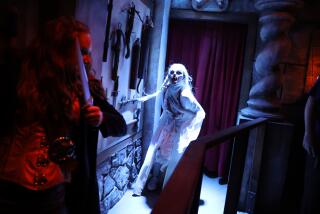Why is the ‘Unsolved Mysteries’ theme song so creepy? We asked the experts
- Share via
Gary Malkin co-wrote the theme music to “Unsolved Mysteries” and knows firsthand just how scary it was to millions of viewers — especially kids who stayed up past their bedtime to watch the reality show in the ’80s and ’90s.
“We used to get letters all the time from parents saying, ‘Could you please change the theme music? Our children are terrified of it,’” he recalled during a recent phone interview.
Now “Unsolved Mysteries” is back, and so is the haunting earworm of a theme song Malkin wrote with Michael Boyd more than 30 years ago.
A revival of the long-running series — which aired on broadcast TV for more than a decade and explored mysteries of all kinds, from unexplained deaths and alien abductions to, um, spontaneous human combustion and the chupacabra — landed this week on Netflix.
A revival of “Unsolved Mysteries” lands on Netflix at a time when true crime is all over TV
While the reboot has been revamped to suit contemporary taste in documentary storytelling, an updated version of the original theme song plays over the opening credits. The song is one of the few distinctive elements of the original that remains in the Netflix revival, but there’s a good reason it made the cut.
There’s still a Facebook group dedicated to the song’s singular ability to provoke a visceral reaction from listeners. And series cocreator Terry Meurer says that over the years, she’s heard more about the theme music than just about any other element of the show — even host Robert Stack’s chilling narration. “The theme is something that everyone comments about — the most, probably.”
Malkin sees “divine justice” in the fact that his music terrified so many kids. When he was growing up in the early ’60s, he was similarly freaked out by the opening notes of the “Perry Mason” theme song. “It scared me to death. I’d start screaming, ‘Don’t put me in bed! There’s somebody under my bed!’” he says.
As a young composer two decades later, Malkin cut his teeth working on the heavily synthesized score for “5 American Guns,” a special about gun violence that Meurer and her partner, John Cosgrove, made for HBO in 1983. The producers used nonactors to re-create real events — which was then a novelty in TV — and Malkin would help write music with what he calls “a you-are-there feeling” to go with the reenactments.
Malkin and Boyd composed the score for the breakdancing movie “Breakin’,” and his dream was to become the next John Williams. He approached true-crime documentaries as if they were narrative features. “You often don’t have good actors [in the reenactments], so you’ve got to have something that’s going to make people feel more, to compensate for the lack of real acting and a serious script,” he says.
The theme song for “Unsolved Mysteries” is “not high art,” Malkin says, “but I think that’s why it worked. It’s very simple building blocks with really great sounds.”
The devil’s interval
He and Boyd came up with the basic elements of the composition in a few hours. “We never dreamed or knew that ‘Unsolved Mysteries’ would become a top-10 TV show.”
It all began with the ostinato — the repeating rhythmic figure that gives the song its sense of urgent, inescapable menace — which he recalls hammering out on a piano. Then he added the “very scary” bass line.
The song also relies on an interval called the tritone. (It is, as Malkin puts it, “an exponential tritone extravaganza.”)
Also known as the devil’s interval or diabolus in musica, the tritone is a dissonant combination of tones that creates a sense of tension, ambiguity and instability, says Neil Lerner, a musicologist who studies music in film and television and teaches at Davidson College. During the Middle Ages and the Renaissance, religious music rarely used the tritone because it created a sense of unease and irresolution rather than majesty or awe.
Synthesizer magic
“The real magic of the theme happened when we went into the studio,” Malkin says.
Boyd, his writing partner, “had a phenomenal sense of what was trendy and contemporary.” And at the time — circa 1987 — nothing was more of-the-moment than the synthesizer.
They worked with a synthesist named Charles Judge, who “brought it all to to life with these sweeping, sliding” pitch bends that resulted in a wailing, siren-like sound and a chilling effect. “He took the pitch bender and hit all the notes in such a creepy way. It was like the way the color white has all the colors in the rainbow.”
The theme also has a “killer drum sound” that Malkin likens to a gunshot or an explosion, which he says added to the tension.
Not even Malkin was immune to the powers of the “Unsolved Mysteries” theme. He recalls that after spending weeks on the complete score for the show, watching reenactments of murders and abductions thousands of times, he went on a camping trip to Mt. Shasta and was plagued by the song. “I couldn’t get it out of my head. I was destroyed for weeks afterwards. I had horrible nightmares.”
The ‘Halloween’ connection
Lerner sees striking similarities between the “Unsolved Mysteries” theme and the signature music from horror movies of the ’70s and ’80s, such as “The Exorcist,” “Nightmare on Elm Street” and, especially, “Halloween.”
“The music in ‘Unsolved Mysteries’ has the [same] repetition” as the sinister theme from “Halloween,” which was composed by John Carpenter, he says in a Zoom call, playing the songs back to back for comparison. “That droning and repeating [in the ‘Unsolved Mysteries’ theme] is part of what makes it ominous. It seems impervious to moving anywhere, and when it does move, it moves into really unexpected places, which is what the ‘Halloween’ theme does.”
“The way that the ‘Halloween’ theme works too is you’ve got that repeating, very simple line at the top and then the slow-moving bass part, and you’ve got the identical thing going on in ‘Unsolved Mysteries’ — the bass part is slowly creeping up and down while that top part just keeps unchanging, doing that same thing, droning,” he says. “It sets up a kind of inevitability — that’s part of it too. The show trades in dread.”
Like “Unsolved Mysteries,” the original “Halloween” score was heavily synthesized, Lerner adds. “Synthesizers are becoming more affordable in the ’70s, so by the late ’70s and into the ’80s, films tended to do that, especially horror films, as it was much cheaper than hiring an orchestra and live players.”
Malkin sees similarities between “Unsolved Mysteries’” theme and the iconic theme music to “The Twilight Zone,” which premiered in 1959. “I was a huge fan of that show. I would say somewhere in the DNA of my consciousness you can’t separate it as an influence.”
Life after ‘Mysteries’
Malkin continued to collaborate with Cosgrove-Meurer Productions until the early 2000s, creating an entire library of spooky music cues for “Unsolved Mysteries.” While he didn’t work on the reboot — the music in the Netflix series was composed by West Dylan Thordson, who also arranged the theme — Malkin’s music continues to find new fans.
Two compilations of music from “Unsolved Mysteries” have been issued on vinyl. (“The theme song and its variations might be the most recognizable and spooky theme song in the history of TV. Truthfully, the music is far better than most film scores,” says Ryan Graveface, owner of Graveface Records, who fondly remembers watching the show while home alone and eating French bread pizza as a 7-year-old.)
Malkin, who lives in Sausalito, stopped composing scores full-time after an accident 20 years ago and started a company called Wisdom of the World, focused on “ways in which music can support people through life’s transitions.” He says the thing he is most known for these days is a book and CD set called “Graceful Passages,” designed to “help people come to terms with mortality.”
“I have completely shifted my focus from ‘Unsolved Mysteries,’ the television show,” he says, “to the true unsolved mysteries of our lives: death and loss.”
More to Read
The complete guide to home viewing
Get Screen Gab for everything about the TV shows and streaming movies everyone’s talking about.
You may occasionally receive promotional content from the Los Angeles Times.






